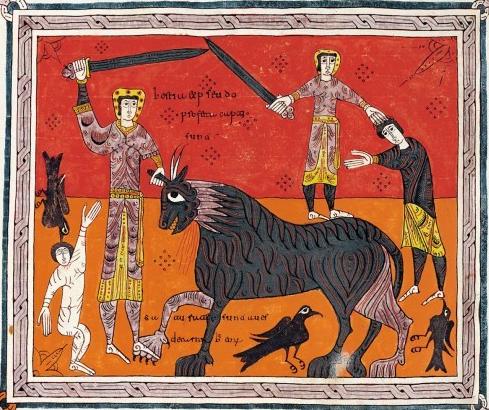Shop Amazon - Create an Amazon Baby Registry

Shop Amazon - Create an Amazon Baby Registry
The Silos Beatus Codex
Commentary on the Apocalypse by Beatus of Liébana, Spain, 1090-1109AD
British Library Add. MS 11695.
Folio f198v. The Triumph of the Rider over the Beast

A larger image of 'The Triumph of the Rider over the Beast', Silos Beatus Codex, Beatus of Liébana, Spain.
The beast, i.e. the devil, and the pseudo prophet – the people of evil and their chiefs – fight Christ and the Church, and are overcome.
The birds shown eating are saints filling themselves with the flesh of their enemies.
The interpretation of the text differs in the Beatus belonging to stemmata I and II.
In the Osma Beatus (f. 152v) the beast – being ridden by a naked figure – is shown held by the muzzle.
It is based on versicle 20 of the storia: bestia et pseudoprofeta capti sunt.
Williams believes this may suggest that only this part of the storia was illustrated traditionally.
It also features in the Beatus belonging to stemma II, whose composition is different from the previous one.
This is apparently one of Maius’ creations (f. 211r).
It is copied exactly in the Girona Beatus (f. 223v) and more freely by Obeco (f. 173v) and Facundus (f. 242v).
Here again, the characteristics peculiar to the Silos Beatus
suggest that it was inspired by a lost codex although the generic concept of the layout stems from the Morgan Beatus.
In stemma II codices, the illustration shares a space with the text and covers half a folio or slightly more.
The Silos Beatus features certain variations with regards to Maius more in line with the storia.
The henchmen are of a higher social class and use swords instead of clubs.
One henchman is about to seize the beast whilst the other raises his weapon to kill the false prophet.
One crow is about to peck one of the prophet’s feet whilst another stares at him threateningly and is about to fly at him.
Yet another bird pecks the head of a naked corpse shown standing upright due to a lack of space.
The text "saturate sunt aves / de carnib[us] eor[um]" explains the mission of the ravenous birds.
Ángela Franco Mata
(Head of the Department of Mediaeval Antiquities of the Museo Arqueológico Nacional)
Source
Referenced as figure 517C in The military technology of classical Islam by D Nicolle
517A to 517E. Manuscript, A - "Troops demolish walls," B - "Goliath," C - "Angels" D - "Angel," E - "Horsemen of the Apocalypse" Beatus, 1091-1109 AD, Mozarab, British Lib., Ms. Add. 11695, ff. 143, 194, 198 and 202 (Hof A).
p433 The majority of Andalusian, and indeed of Spanish, cavalry would still not have owned hauberks. They might, however, have worn felt or leather armour of a style similar to that seen in the 10th century (Figs.
497, 499, 511 and 514
). One such armour is almost certainly worn by a foot soldier in a Mozarabic manuscript from this period. Here it seems to be made of large pieces crudely stitched together (Fig.
517
). Yet these illustrated sources remain far from clear. Others, which may show Andalusian warriors, almost certainly illustrate unarmoured light cavalry, although even here a hauberk could be hidden beneath another garment in a style fashionable elsewhere in Islam (Figs.
490 and 510).
Referenced on p.3, El Cid and the Reconquista. Warfare in Medieval Spain 1050-1492 by David Nicolle
Beatus Commentaries on the Apocalypse, 1091-1109. In this Mozarabic manuscript an angel fights the Beast, wielding a sword with a trilobate pommel and wearing an outer garment of large pieces of heavy material stitched together - perhaps of buff leather (Ms. Add. 11695, British Lib., London.)
Previous Next
Commentary on the Apocalypse by Beatus of Liébana, The Silos Beatus Codex, Spain, 1090-1109AD


